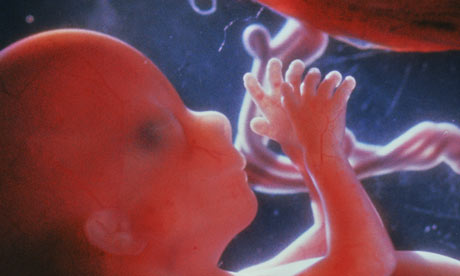 Scientists have established beyond doubt that in rare cases cancer can be transmitted in the womb, following the birth of a baby to a woman with leukaemia.
Scientists have established beyond doubt that in rare cases cancer can be transmitted in the womb, following the birth of a baby to a woman with leukaemia.A team at the Institute of Cancer Research, a college of the University of London, working with colleagues in Japan, found that the cancer had defied accepted theories of biology. Leukaemia cells had crossed the placenta and spread from the 28-year-old mother to her unborn baby.
Dr Tony Ford on how cancer can pass from the woman to foetus in the womb Link to this audioThere have been suspicions for years that cancer could be passed on in the womb. About 17 cases of suspected mother-to-child transmission have been noted – usually leukaemia or melanoma. But until now researchers have been unable to establish whether it had happened and, if so, how.
If the cells did cross the placental barrier, the child's immune system should have recognised them as foreign invaders and destroyed them.
In the latest case no one knew the mother, who was Japanese, had cancer during her pregnancy. She had a normal delivery in hospital, giving birth to an apparently healthy baby girl.
But just over a month later the mother developed vaginal bleeding, which became uncontrollable. She was diagnosed with an advanced stage of leukaemia and died.
When the baby was 11 months old she was brought to hospital with a swollen right cheek. Tests showed she had a tumour in her jaw and the cancer had spread to her lungs.
Although the cancers were not the same – the baby had a lymphoma and is now in remission – the Japanese doctors suspected a link to the leukaemia that had killed her mother.
They called in the team at the Institute of Cancer Research, which has done a lot of work in recent years on the genetics of cancers of identical twins. In the journal Proceedings of the National Academy of Sciences, the researchers explain how they used genetic "fingerprinting" techniques to establish that the child's cancer cells came from the mother.
They found the cancer cells of mother and baby carried the identical mutated cancer gene (called BCR-ABL1), but the infant had not inherited this gene. This meant that the child could not have developed the cancer in isolation – the cells must have come from the mother.
To investigate how leukaemia cells could have crossed the placental barrier and survived in the baby, the scientists looked for evidence of some form of immunological acceptance or tolerance of the foreign cells by the foetus. They examined the genes of the cancer cells in the infant and found a deletion mutation – some DNA missing in the region that controls expression of the major histocompatibility locus (HLA).
This was significant because HLA molecules primarily distinguish one individual, and his or her cells, from another, so the absence of these on the cancer cells meant the infant's immune system would not have recognised that they were foreign.
Professor Mel Greaves, who led the study, said: "It appears that in this and, we presume, other cases of mother-to-offspring cancer, the maternal cancer cells did cross the placenta into the developing foetus and succeeded in implanting because they were invisible to the immune system. We are pleased to have resolved this longstanding puzzle.
"But we stress … the chances of any pregnant woman with cancer passing it on to her child are remote."
Dr David Grant, scientific director at Leukaemia Research, said: "The important message from this … is that leukaemia cells can be destroyed by the immune system. Harnessing the power of the immune system to cure and protect patients from leukaemia is one of our priority areas of research."
http://www.guardian.co.uk/science/2009/oct/12/cancer-passed-from-mother-foetus









